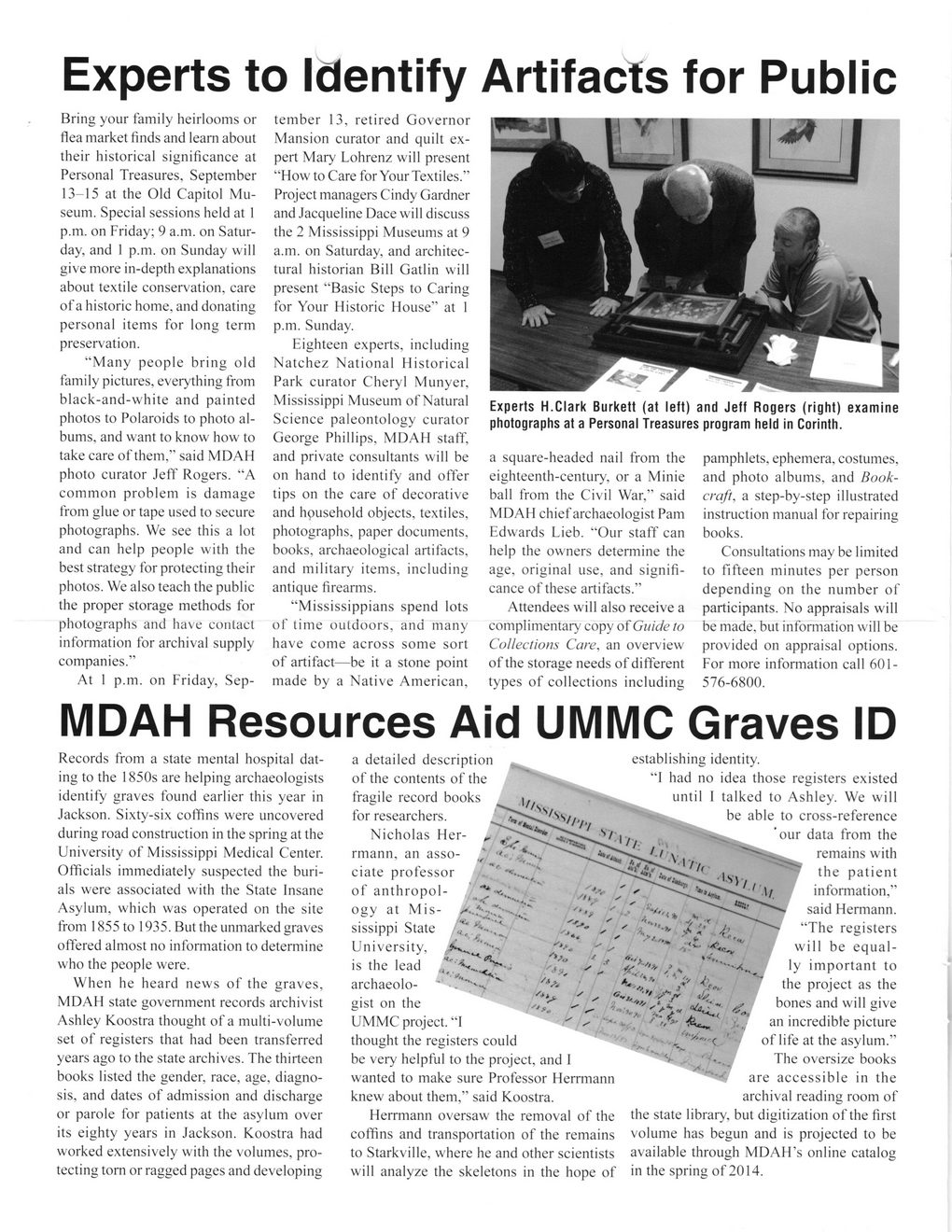This text was obtained via automated optical character recognition.
It has not been edited and may therefore contain several errors.
Experts to Identify Artifacts for Public Bring your family heirlooms or flea market finds and learn about their historical significance at Personal Treasures, September 13-15 at the Old Capitol Museum. Special sessions held at I p.m. on Friday; 9 a.m. on Saturday, and 1 p.m. on Sunday will give more in-depth explanations about textile conservation, care of a historic home, and donating personal items for long term preservation. “Many people bring old family pictures, everything from black-and-white and painted photos to Polaroids to photo albums, and want to know how to take care of them,” said MDAH photo curator Jeff Rogers. “A common problem is damage from glue or tape used to secure photographs. We see this a lot and can help people with the best strategy for protecting their photos. We also teach the public the proper storage methods for photographs and have contact information for archival supply companies.” At 1 p.m. on Friday, Sep- tember 13, retired Governor Mansion curator and quilt expert Mary Lohrenz will present “How to Care for Your Texti les.” Project managers Cindy Gardner and Jacqueline Dace will discuss the 2 Mississippi Museums at 9 a.m. on Saturday, and architectural historian Bill Gatlin will present “Basic Steps to Caring for Your Historic House” at 1 p.m. Sunday. Eighteen experts, including Natchez National Historical Park curator Cheryl Munyer, Mississippi Museum of Natural Science paleontology curator George Phillips, MDAH staff, and private consultants will be on hand to identify and offer tips on the care of decorative and household objects, textiles, photographs, paper documents, books, archaeological artifacts, and military items, including antique firearms. “Mississippians spend lots of time outdoors, and many have come across some sort of artifact—be it a stone point made by a Native American, Experts H.Clark Burkett (at left) and Jeff Rogers (right) examine photographs at a Personal Treasures program held in Corinth. a square-headed nail from the eighteenth-century, or a Minie ball from the Civil War,” said MDAH chief archaeologist Pam Edwards Lieb. “Our staff can help the owners determine the age, original use, and significance of these artifacts.” Attendees will also receive a complimentary copy of Guide to Collections Care, an overview of the storage needs of different types of collections including pamphlets, ephemera, costumes, and photo albums, and Book-craft, a step-by-step illustrated instruction manual for repairing books. Consultations may be limited to fifteen minutes per person depending on the number of participants. No appraisals will be made, but information will be provided on appraisal options. For more information call 601 -576-6800. MDAH Resources Aid UMMC Graves ID Records from a state mental hospital dating to the 1850s are helping archaeologists identify graves found earlier this year in Jackson. Sixty-six coffins were uncovered during road construction in the spring at the University of Mississippi Medical Center. Officials immediately suspected the burials were associated with the State Insane Asylum, which was operated on the site from 1855 to 1935. But the unmarked graves offered almost no information to determine who the people were. When he heard news of the graves, MDAH state government records archivist Ashley Koostra thought of a multi-volume set of registers that had been transferred years ago to the state archives. The thirteen books listed the gender, race, age, diagnosis, and dates of admission and discharge or parole for patients at the asylum over its eighty years in Jackson. Koostra had worked extensively with the volumes, protecting tom or ragged pages and developing a detailed description of the contents of the fragile record books for researchers. Nicholas Her- , rmann, an asso-ciate professor of anthropology at Mis- /*■.*• sissippi State ^ University, is the lead archaeologist on the UMMC project. “I ^ ^ ' • thought the registers could be very helpful to the project, and I wanted to make sure Professor Herrmann knew about them,” said Koostra. Herrmann oversaw the removal of the coffins and transportation of the remains to Starkville, where he and other scientists will analyze the skeletons in the hope of establishing identity. “I had no idea those registers existed until 1 talked to Ashley. We will to cross-reference our data from the remains with the patient information,” said Hermann. The registers will be equally important to the project as the bones and will give an incredible picture ■ of life at the asylum.” ' V . The oversize books are accessible in the archival reading room of the state library, but digitization of the first volume has begun and is projected to be available through MDAH’s online catalog in the spring of 2014.

Mississippi History Newsletter 2013 Fall (2)